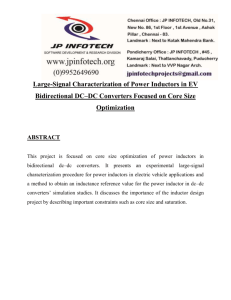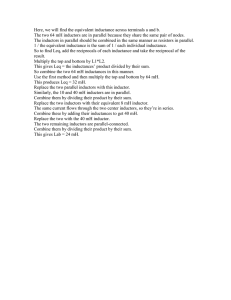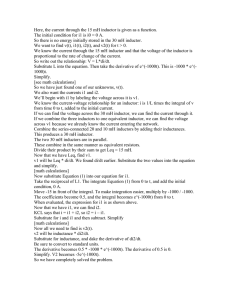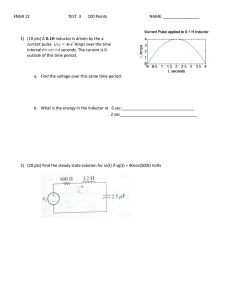Regulators Embed Inductors to Save Space and
advertisement
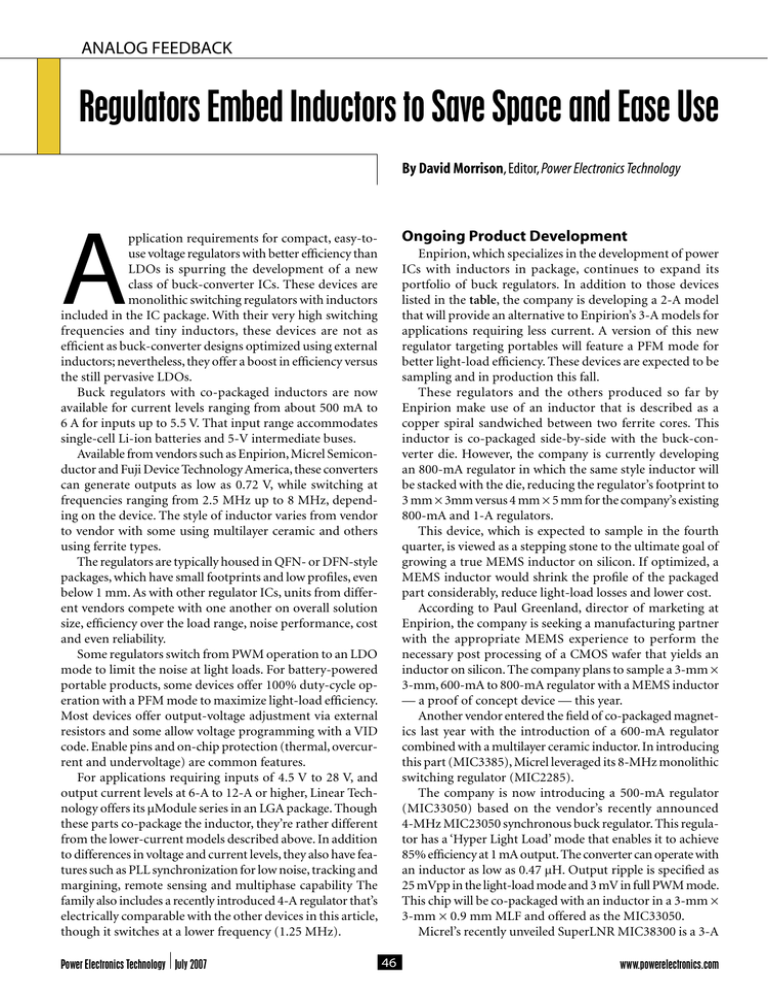
ANALOG FEEDBACK Regulators Embed Inductors to Save Space and Ease Use By David Morrison, Editor, Power Electronics Technology A Ongoing Product Development pplication requirements for compact, easy-touse voltage regulators with better efficiency than LDOs is spurring the development of a new class of buck-converter ICs. These devices are monolithic switching regulators with inductors included in the IC package. With their very high switching frequencies and tiny inductors, these devices are not as efficient as buck-converter designs optimized using external inductors; nevertheless, they offer a boost in efficiency versus the still pervasive LDOs. Buck regulators with co-packaged inductors are now available for current levels ranging from about 500 mA to 6 A for inputs up to 5.5 V. That input range accommodates single-cell Li-ion batteries and 5-V intermediate buses. Available from vendors such as Enpirion, Micrel Semiconductor and Fuji Device Technology America, these converters can generate outputs as low as 0.72 V, while switching at frequencies ranging from 2.5 MHz up to 8 MHz, depending on the device. The style of inductor varies from vendor to vendor with some using multilayer ceramic and others using ferrite types. The regulators are typically housed in QFN- or DFN-style packages, which have small footprints and low profiles, even below 1 mm. As with other regulator ICs, units from different vendors compete with one another on overall solution size, efficiency over the load range, noise performance, cost and even reliability. Some regulators switch from PWM operation to an LDO mode to limit the noise at light loads. For battery-powered portable products, some devices offer 100% duty-cycle operation with a PFM mode to maximize light-load efficiency. Most devices offer output-voltage adjustment via external resistors and some allow voltage programming with a VID code. Enable pins and on-chip protection (thermal, overcurrent and undervoltage) are common features. For applications requiring inputs of 4.5 V to 28 V, and output current levels at 6-A to 12-A or higher, Linear Technology offers its µModule series in an LGA package. Though these parts co-package the inductor, they’re rather different from the lower-current models described above. In addition to differences in voltage and current levels, they also have features such as PLL synchronization for low noise, tracking and margining, remote sensing and multiphase capability The family also includes a recently introduced 4-A regulator that’s electrically comparable with the other devices in this article, though it switches at a lower frequency (1.25 MHz). Power Electronics Technology July 2007 Enpirion, which specializes in the development of power ICs with inductors in package, continues to expand its portfolio of buck regulators. In addition to those devices listed in the table, the company is developing a 2-A model that will provide an alternative to Enpirion’s 3-A models for applications requiring less current. A version of this new regulator targeting portables will feature a PFM mode for better light-load efficiency. These devices are expected to be sampling and in production this fall. These regulators and the others produced so far by Enpirion make use of an inductor that is described as a copper spiral sandwiched between two ferrite cores. This inductor is co-packaged side-by-side with the buck-converter die. However, the company is currently developing an 800-mA regulator in which the same style inductor will be stacked with the die, reducing the regulator’s footprint to 3 mm × 3mm versus 4 mm × 5 mm for the company’s existing 800-mA and 1-A regulators. This device, which is expected to sample in the fourth quarter, is viewed as a stepping stone to the ultimate goal of growing a true MEMS inductor on silicon. If optimized, a MEMS inductor would shrink the profile of the packaged part considerably, reduce light-load losses and lower cost. According to Paul Greenland, director of marketing at Enpirion, the company is seeking a manufacturing partner with the appropriate MEMS experience to perform the necessary post processing of a CMOS wafer that yields an inductor on silicon. The company plans to sample a 3-mm × 3-mm, 600-mA to 800-mA regulator with a MEMS inductor — a proof of concept device — this year. Another vendor entered the field of co-packaged magnetics last year with the introduction of a 600-mA regulator combined with a multilayer ceramic inductor. In introducing this part (MIC3385), Micrel leveraged its 8-MHz monolithic switching regulator (MIC2285). The company is now introducing a 500-mA regulator (MIC33050) based on the vendor’s recently announced 4-MHz MIC23050 synchronous buck regulator. This regulator has a ‘Hyper Light Load’ mode that enables it to achieve 85% efficiency at 1 mA output. The converter can operate with an inductor as low as 0.47 µH. Output ripple is specified as 25 mVpp in the light-load mode and 3 mV in full PWM mode. This chip will be co-packaged with an inductor in a 3-mm × 3-mm × 0.9 mm MLF and offered as the MIC33050. Micrel’s recently unveiled SuperLNR MIC38300 is a 3-A 46 www.powerelectronics.com Model Enpirion EN5330 Input (V) Output (V) Current Switching frequency (MHz) 2.375 to 5.5 0.8 to 3.3 3A 5 Inductor Size (mm), package Cost* (intro date) Copper spiral 8.1 × 12.5 × 2.2, $4.95 ea/1000 on ferrite 36-pin DFN (May 2004) Enpirion EP5352Q, EP5362Q Enpirion EN5360D (2nd gen part) Enpirion EN5336Q (2nd gen part) 2.4 to 5.5 0.8 to 3.3 500 mA (’52), 600 mA (’62) 5 Same 4 × 5 × 1.1, QFN20 $1.50 ea/1000 (Aug. 2006) 2.375 to 5.5 0.8 to 3.3 6A 5 Same 8.1 × 17 × 2.2, DFN48 $4.36 ea/1000 (Nov. 2006) 2.375 to 5.5 0.8 to 3.3 3A 5 Same 7.5 × 10 × 1.85, $2.94 ea/1000 QFN44 (Nov. 2006) Micrel Semi. MIC3385 2.7 to 5.5 as low as 1.0 600 mA 8 Micrel Semi. MIC33050 2.7 to 5.5 0.72 to 2.5 500 mA 4 3A Not specified Not specified 500 mA at 1.5 V out 2.5 Ferrite 10 A cont., 14 A peak 0.850, typ. at full load Shielded low-profile inductor 6 A or 12 A, 0.850, typ. parallel for at full load higher current Shielded low-profile inductor Micrel SuperLNR MIC38300 Fuji Device Tech. FB6831J 3.0 to 5.5 2.7 to 5.5 as low as 1.0 as low as 0.8 Linear Technology LTM4600 DC/DC µModule 4.5 to 20 (or 28 V) 0.6 to 5 Linear Technology LTM4601/02/03 DC/DC µModule 4.5 to 20 (or 28) 0.6 to 5 Linear Technology LTM4604 µModule 2.35 to 5.5 0.8 to 5 4A 1.25 Multilayer ceramic inductor Multilayer ceramic inductor Shielded low-profile inductor 3 × 3.5 × 0.9, 14-pin MLF $1.75 ea/1000 (Nov. 2006) 3 × 3 × 0.9, MLF $1.75 ea/1000 (Q3 2007) 4 × 6 × 0.9, $3.95 ea/1000 28-pin MLF (June 2007) 2.95 × 2.4 × 1.0, $1.50 ea/1000 10-pin SON (Fall 2006) $16.50 15 × 15 × 2.8, ea/1000 LGA for 20 V (Oct. 2005) $11.95 15 × 15 × 2.8, ea/1000 LGA (Nov. 2006) 15 × 9 × 2.3, LGA $8.95 ea/1000 (June 2007) *Approximate or “starting at” pricing at time of introduction. Table. Buck converter ICs with co-packaged inductors. regulator-inductor combination, but one that employs a novel switcher plus LDO architecture. The device promises the transient response, PSRR and noise performance of an LDO with the efficiency of a switcher. The device specifies less than 5 mV of pk-to-pk noise, greater than 70 dB PSRR at 1 kHz. When stepping down a 3.3-V input to 1.2-V output at 3 A, power dissipation for the MIC38300 is 1.5 W, which corresponds to 70.6% efficiency. Meanwhile the company also continues to develop conventional switching regulators with co-packaged inductors. According to Ralf Muenster, Micrel’s marketing director, Micrel is working on a 300-mA regulator in a 2-mm × 2-mm footprint. To develop this part, the company is evaluating inductors in 0402 and 0603 case sizes with profiles of 0.5 mm and below. These devices represent a further miniaturization of inductors for which 0805 cases are currently the smallest available. Inductance value for the new part will be in the 100-nH to 470-nH range. One of the previous barriers to co-packaging inductors was the limited availability of high-frequency and low-profile inductors for low-current buck regulators. However, Muenster says it’s now possible to find several off-the-shelf inductors www.powerelectronics.com with profiles below 1 mm in inductance values up to about 2.2 µH. Although, there is still a need for more high-frequency options, several vendors now offer inductors for 4-MHz operation, says Tony Armstrong, product marketing manager for the Power Products Group at Linear Technology. Introduced last fall, Fuji Device Technology Ameria’s FB6831J is a 500-mA synchronous buck regulator employs a ferrite substrate that serves as both an inductor and a platform for the device. The 2.5-MHz switching frequency on this device is lower than the competing regulators but device size is comparable. Efficiency in converting 3.6 V to 1.8 V peaks at about 90% at 200-mA output. An LDO mode permits low-noise, light-load operation. The company is currently developing or planning several related parts with embedded inductors. One part in development, the FB6832J, will be a 400-mA-rated buck regulator with low-power consumption at light load. Other parts in planning include 300-mA versions with either LDO mode or low power at light load. The company is also planning a 600-mA buck-boost regulator, a dual 100-mA (single inductor) buck regulator and a 400-mA buck regulator with 800-mA bypass switch for RF PA applications. PETech 47 Power Electronics Technology July 2007


